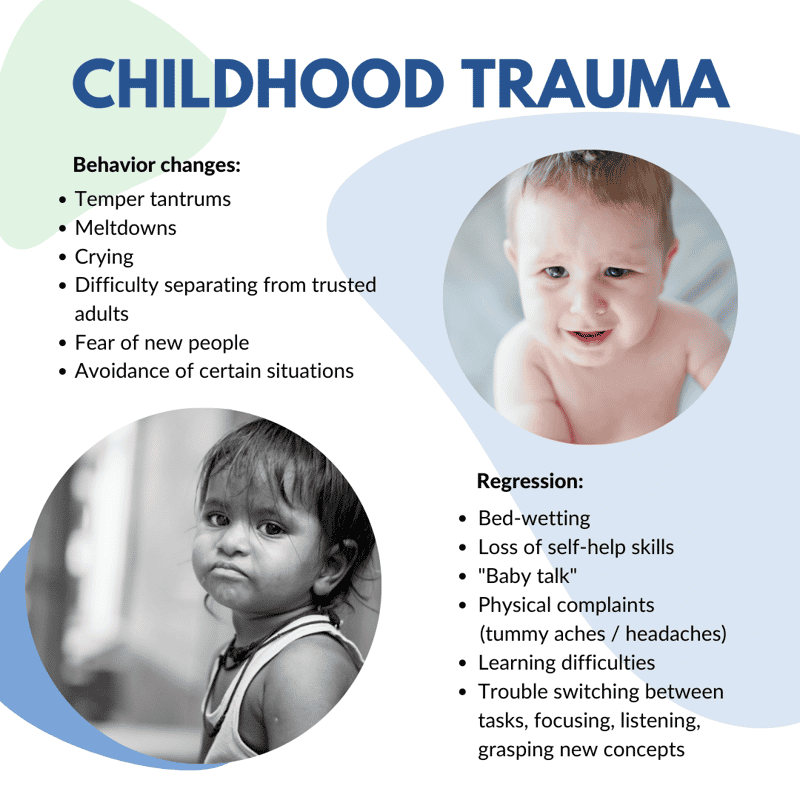
In this blog, we discuss what is childhood trauma, how to recognize the signs, and the do's and don'ts for what to do or not do when you suspect a child has trauma. So, let's start by trying to truly understand trauma.
⚠️ Be sure to read on to download the printable pdfs!
The New Year often represents a time of reflection – thinking back on the previous year’s challenges, experiences, and all that we are leaving behind, and marking the start of a new beginning. However, children (and adults) dealing with unresolved trauma may be bringing the resulting feelings and dysregulation into the New Year with them. Although there is much for us to be hopeful for, the past few years of uncertainty have left their mark on us all. Disruption and unpredictability combined with a lack of consistent nurturing relationships have manifested as trauma in many children.
But how can we provide children with the level of support needed as a buffer against childhood adversity? How can we foster coping skills and resilience to set children on the right path forward in 2023?
In order to manage something overwhelming, we first need to be able to identify it and understand the cause behind it. So, let's start by trying to truly understand trauma.
Childhood trauma, according to the National Institute of Mental Health, can be defined as “the experience of an event by a child that is emotionally painful or distressful, which often results in lasting mental and physical effects.”
Traumatic experiences for young children can range from bullying, losing a pet, sudden illness, exposure to violence, the sudden death of a loved one, a natural disaster, neglect, or abuse. What all these experiences have in common is that they are all major changes or disruptions that can result in trauma for young children.
Childhood trauma manifests itself in many different ways – some obvious, and some not. As caregivers, it is our responsibility to know what signs to look out for. Childhood trauma can bring forth feelings of fear, anxiety, helplessness, depression, guilt, and even shame.

🖨️ Download Signs of Childhood Trauma (PDF)
With these feelings come behavioral changes such as temper tantrums, meltdowns, crying, difficulty separating from trusted adults, fear of new people, and avoidance of certain situations like going to school.
Children may experience regressive behaviors such as bedwetting, loss of self-help skills, “babytalk,” and physical complaints such as tummy aches or headaches. Children dealing with trauma may also experience learning difficulties, impacting their ability to switch between tasks, focus, listen, and grasp new concepts.
Once we recognize the signs of trauma in children, it may feel overwhelming to know where to start to begin supporting the children in our care. As caregivers, an important part of our job is helping children begin to heal, succeed, and thrive in learning and in life. Dr. Donna Housman, founder of Housman Institute and the ECSEL (Emotional, Cognitive, and Social Early Learning) approach, identifies three important facts that we should consider when supporting children dealing with trauma.
|
The ECSEL approach goes beyond SEL by training caregivers first in the skills of emotional intelligence so they can support these same skills in children, use emotional situations as learning opportunities, and build the supportive, nurturing, and responsive relationships that all children need most.
As some of children’s first key socializers and role models, caregivers play a critical part in children’s development of emotional intelligence and coping skills. This means that ensuring all social-emotional learning is also trauma-informed makes a world of difference.
Children need to be nurtured within responsive relationships with caregivers who have learned about trauma, trauma-informed techniques, emotional intelligence, and coping skills for themselves first.
In fact, a revised policy statement on childhood toxic stress issued by the American Academy of Pediatrics states, “...safe, stable, and nurturing relationships not only buffer childhood adversity when it occurs, but also promote the capacities needed to be resilient in the future.”
This is why the ECSEL approach is based on trauma-informed practices – to train caregivers in the skills they need to be the buffer for childhood adversity, teach emotional intelligence, and promote coping skills for lifelong resilience.
Caregivers cannot support children in developing coping skills, nor can we be part of the responsive relationships that children need, unless we have done the work ourselves. So, let’s start this important work with 15 do’s and don'ts of supporting children dealing with trauma.
Related: How to Talk to Kids About Tough Topics

🖨️Download Do's and Don'ts of Trauma-Informed Care (PDF)
✅DO build trusting relationships with children. Make yourself available to talk, listen to, and help children through the big feelings trauma can bring to the surface.
✅DO become aware of your own emotions, responses, and reactions. Children observe how you react, respond, and manage your own emotions and internalize your actions. Make sure you are modeling appropriate coping strategies.
✅DO become attuned to children’s emotions and behaviors, including any uncharacteristic changes. Observing children’s actions, reactions, emotions, and responses and knowing what signs to look for helps caregivers provide the appropriate support to meet children’s needs.
✅DO help children acknowledge and accept all emotions, even the prickly ones. All feelings are valid, it’s what we do with them that matters most!
✅DO create safe learning environments. Encourage children’s expression of emotions, exploration, creativity, and play. Establish consistent routines to help children feel secure and anticipate what comes next. Related: Design a Home With PTSD in Mind
✅DO guide children to identify, understand, express, and regulate their big feelings. Help children label feelings by name and understand the connection between feelings, causes, and related behaviors. Support children in constructively expressing their emotions verbally and non-verbally and encourage them to engage in regulation strategies together (such as deep breathing) that help them learn important coping skills.
✅DO use the heat-of-the-moment as a learning opportunity. Model calmness in the heat of the moment, support children in finding regulation strategies to calm down, and guide appropriate language and problem-solving skills sensitively.
✅DO use developmentally appropriate books to help children explore challenging experiences. 📖Books such as Gilly and the Garden by Dr. Donna Housman explore complex themes of loss and grief. This book was written with a trauma-informed lens to help children understand the emotions that come with loss and how to cope.
🚫DON’T encourage children to discuss traumatic experiences before they’re ready. Instead, answer questions sensitively in a way that is developmentally appropriate. Be honest and brief in your responses and encourage children to continue asking questions.
🚫DON’T set false expectations of positivity for children. Avoid language such as, “It will be okay, you don’t need to be scared.” Instead, provide understanding and reassurance by saying, “I understand you are feeling scared. Do you remember that taking three big belly breaths helped you feel better the last time you were scared? Let’s try that together now.”
🚫DON’T be reactive in the heat-of-the-moment when responding to children’s behaviors. Instead, remind yourself that challenging or regressive behaviors are a sign of trauma. Model calmness and empathy in the heat of the moment and guide children in rechanneling their actions into words.
🚫DON’T respond to children with judgment or criticism. Instead, respond with empathy, understanding, validation, and reassurance.
🚫DON’T close the door to inappropriate behaviors without explanation. Remember that when you close the door to an inappropriate behavior, always open the door to an appropriate one. Manage children’s behaviors sensitively and positively by explaining why certain behaviors are not okay and providing simple choices for what they can do instead.
🚫DON’T assume all children deal with trauma the same way. Instead, focus on listening, learning, and understanding. Meet children where they are and adjust your approach when necessary.
🚫DON’T tell children what will help them feel better. Instead, present several simple options and allow them to choose. This helps children develop self-confidence, control, agency, and independence.
These Posts on Parenting
Housman Institute, LLC
831 Beacon Street, Suite 407
Newton, MA 02459
info@housmaninstitute.org
(508)379-3012
Explore
Our Products
Legal
Connect
Contact
Join our Mailing List!
Subscribe to receive our newsletter, latest blogs, and ECSEL resources.
We respect and value your privacy.
No Comments Yet
Let us know what you think